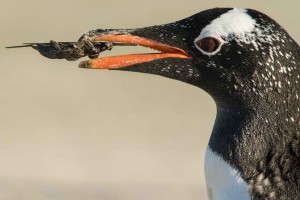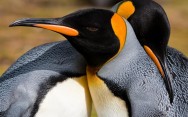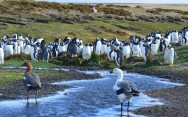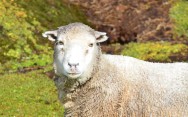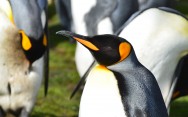GENTOO PENGUINS (PYGOSCELIS PAPUA)
The first thing you see when you arrive at Volunteer Point are the Gentoo Penguins walking to and from the beach, or standing and playing on Volunteer Green. If you are driving, no doubt the pedestrians walking alongside your path will have the distinctive wide white stripe across the top of their heads and long, stiff tail feathers and a bright orange beak.
Watching them on the beach is amazing, waddling along behind each other, scanning the sea for sea lions before venturing out to fish. Or, like shoals of flying fish, popping their head up out of the water at a distance ensuring those seal lions aren’t blocking their way before they come in at 30 mph hitting shoreline at speed.
Reaching heights of 20 – 35 inches (51 – 90 cm) they are the 3rd largest penguin in the world and the 2nd largest at Volunteer Point, overtaken only by the colourful and majestic King Penguins. Their tail sticks out behind them making sweeping movements as they waddle along.
Volunteer Green in 2015 was home to approximately 3600 breeding pairs of Gentoo’s, each producing on average 1 newborn. This varies year on year dependant on weather and food supply.
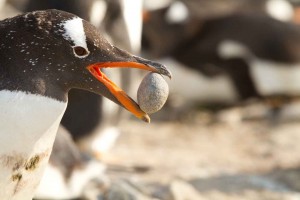
A Gentoo nest building
The flat land around Volunteer Green is ideally suited to the Gentoos who set about making their nests from the nearby sticks, stones and grasses. Sticks and stones are an important commodity in the Gentoo world especially amongst the females, with other gentoo nests frequently raided for the best looking ones with some females paying their males in sexual favours for a nice stone.
The Gentoo Penguins have their own well used routes to and from the colonies also know as penguin highways. Those people lucky enough to stay overnight at the wardens lodge will be able to witness the “rush hour traffic” in the evening as they arrive back from the sea. Sunrise is also a great time to see the traffic heading in the opposite direction.
These very inquisitive creatures are really happy to come and meet you close up if you sit still and none threatening but whatever you do don’t force your presence on them, especially in the breeding areas. Doing so may cause them to leave their nests putting their eggs or young at risk of predators.
The Gentoo calls in a variety of ways with the most distinctive call being a loud trumpeting which they do with their heads thrown back. Another amusing thing is watching the “chick chase”. You’ll often see one or two chicks chasing their parent rather fast through the colonies to get fed. They stay close and reach good speeds, it is believed this behaviour encourages the chicks to eventually follow their parents out to sea whilst also building up their strength. They will run in front of you, around you, in every direction.
They feed on Krill, fish, squat lobsters, and squid normally within 20 km of shore, heading out in the waters from early morning to late afternoon. Heading out to sea the Gentoos have threats from sea lions, leopard seals and killer whales, whilst on land the adults don’t really have any threats, the eggs and chicks however do get attacked by skua.
At Volunteers you’ll see a few breeding areas for the gentoos as well as along the green edge where the young wait for their parents to come back from sea. They also hang out by the tufts of grass and in the dunes. In other areas gentoos will breed as far as 3 km away from the shoreline. They tend to be faithful creatures, coming back to the same breeding ground and the same partner for years.
There is nothing more beautiful on our planet than nature. These gentle birds trust us to be around them, and they enjoy it when you are. If you do want to sit or lie down close to them just remember, you are probably going to be doing so in their guano, and it doesn’t smell that nice for your fellow travellers in the car on the journey back to Stanley. 


